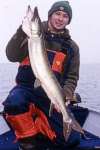| In this issue:
ALL NEW ONTARIO FISHING MESSAGE BOARD
CLICK HERE!
| Charlton Lake Camp - Charlton Lake Camp is a housekeeping cottage resort set among
towering pines in Northern Ontario's La Cloche Mountains. The camp offers fishing (bass,
walleye, pike and lake trout), swimming, boating and hunting. Eco-tourists will love the
easy access to Killarney Provincial Park for canoeing, kayaking and hiking. Artists and
photographers will revel in the same natural beauty made famous by the Group of Seven. |
| Opimika Wilderness
Camp & Cottages - Opimika Wilderness Camp &
Cottages is a remote wilderness lodge, open year round. Fish, hunt, ATV & snowmobile
at Opimika. We offer fully equipped cottages with kitchen and bathroom, camps and outpost
cottage. You will have access to 30 lakes within 10kms of the lodge. Fish for Walleye,
Northern Pike, Bass & Trout. Hunt for moose, deer & bear. |
| Island
10 Fishing Retreat - Island 10
nestles among pine-clad islands dotting the water on Lady
Evelyn Lake. With over 650 miles of shoreline, the area is
very remote,secluded and definitely a non-commercial area with
excellent fishing. There are no roads to Lady Evelyn Lake. It
is accessible only by boat or plane. As a result of our prime
location, good fishing is just a short distance away, and
guides are simply not necessary |
|
"Choosing The Right Fishing
Line" By Justin Hoffman
 The strongest, and most fragile link you have between yourself and a fish is
undoubtedly your fishing line. Choosing an inferior product in order to save a few bucks,
or picking the wrong style for the type of fishing you do, can lead to heartbreak when out
on the water. So what are the best lines to choose and when should you use them? The
following will hopefully explain the subtleties of the common "fishing line." The strongest, and most fragile link you have between yourself and a fish is
undoubtedly your fishing line. Choosing an inferior product in order to save a few bucks,
or picking the wrong style for the type of fishing you do, can lead to heartbreak when out
on the water. So what are the best lines to choose and when should you use them? The
following will hopefully explain the subtleties of the common "fishing line."
Monofilament
Monofilament is the most commonly used line when it comes to fishing, and is a
mainstay on the majority of angler's reels. The one problem many anglers make the mistake
of is buying the cheapest mono they can find. In fishing, you normally get what you paid
for, so spend a little bit extra and buy a reputable brand. Berkley Trilene, SilverThread,
Stren and Ande all have proven track records, and make a high-quality line. It is also
important to change your line regularly - at the bare minimum once a season - as the sun
and water will break down the line, leaving it weak and partial to breakage.
Mono is a great line to choose when you are faced with clear water conditions. This type
of line is virtually invisible once it is under the water's surface, and can really up
your odds for "line-shy" fish and those with excellent eyesight. Mono can be
used for virtually every fishing situation you may encounter, and it is generally regarded
as the best all around fishing line for all situations. (Braided lines fill some of these
cracks when it comes to specific techniques.)
Monofilament will stretch a fair bit on hook sets, so extra force is generally required to
drive the hook home. (Compared to the no-stretch traits that braided lines have, where
less force is definitely needed.) Mono is generally a strong line, most are extremely
abrasion resistant and are thin in diametre. One problem that many find with mono is the
"reel memory" that this type of line has. Coils and loops are common occurrences
for the mono angler, which can lead to backlashes and knotted lines on reel spools. One
remedy for this unpleasant aspect is to make sure you are using the correct line weight
for the reel size you are using. Unless you are doing Great Lakes salmon fishing with a
spinning reel, the maximum line strength I suggest for freshwater applications is
ten-pound test. Anything higher and coils, backlashes and tangles will rear their ugly
heads. Your distance and accuracy will also suffer by going above this recommendation.
Anything higher than ten-pound test is best fished on a baitcasting reels. There are
certain situations and styles of fishing that afford some leeway in this generalization,
but for most anglers chasing bass, walleye or panfish, this advice will make your fishing
much more enjoyable.
The Braided Lines
Braided lines have come on strongly over the past few years, and more and more
anglers are realizing the advantages these lines possess for specific situations and
techniques. Braided lines are made by "braiding" or "weaving" fibers
of a man-made material like Spectra or Micro-Dyneema into a strand of line. This process
produces a line that is very strong, extremely abrasion resistant and has virtually no
stretch whatsoever. |